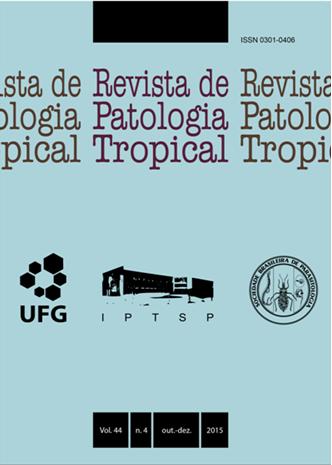THE PREVALENCE OF INTESTINAL PARASITOSIS ACCORDING TO GENDER IN A UNIVERSITY HOSPITAL IN SOUTHERN BRAZIL
DOI:
https://doi.org/10.5216/rpt.v44i4.39240Keywords:
Gender, enteroparasitosis, parasites, helminths, Giardia lamblia.Abstract
Introduction: Intestinal parasitoses lead to high morbidity and mortality rates, mainly in endemic areas; however, little is known about their prevalence in the Southern region of Brazil. The aim of the current study is to report the prevalence of intestinal parasitosis and to assess such prevalence according to gender. Methods: Analytical, transversal and retrospective design including parasitological stool tests performed in a university hospital. Results: We included 3,126 parasitological stool test results in the study – 44% of them were from men and 10.1% of the total were positive. Commensal protozoa were the most frequent parasites (7.7%) and Endolimax nana was the most prevalent protozoan (3.7%). Giardia lamblia was the most frequent pathogenic parasite (1.3%), and it was followed by Strongyloides stercoralis (0.7%). Men presented higher positive result rates (13.0% vs. 7.8%; p<0.001) for commensal (7.2% vs. 5.1%; p=0.016) and pathogenic parasites (4.5% vs. 1.8%; p<0.001); as well as for protozoa (10.7% vs. 6.4%; p<0.001) and for nematodes (1.4% vs. 0.6%; p=0.036). Similarly, men presented a higher positive result ratio for E. nana (5.2% vs. 2.6%; p<0.001), Entamoeba coli (3.5% vs. 1.6%; p<0.001), G. lamblia (2.2% vs. 0.6%; p<0.001) and S. stercoralis (1.1% vs. 0.3%; p=0.013) than women. Conclusion: parasites were found in 10% of the examined samples and commensal parasites were the most prevalent. Men showed higher enteroparasitosis rates than women.Downloads
Downloads
Published
How to Cite
Issue
Section
License
The manuscript submission must be accompanied by a letter signed by all authors stating the full name and email address, confirming that the material has not been published or is under consideration for publication elsewhere, and agreeing to transfer copyright in all media and formats for Journal of Tropical Pathology. The authors will not be paid for published articles. They are solely responsible for the content of those articles, even if the Editor holds the right to adjust them to the norms of the journal.
The reviewers will not be paid for the peer review process.

